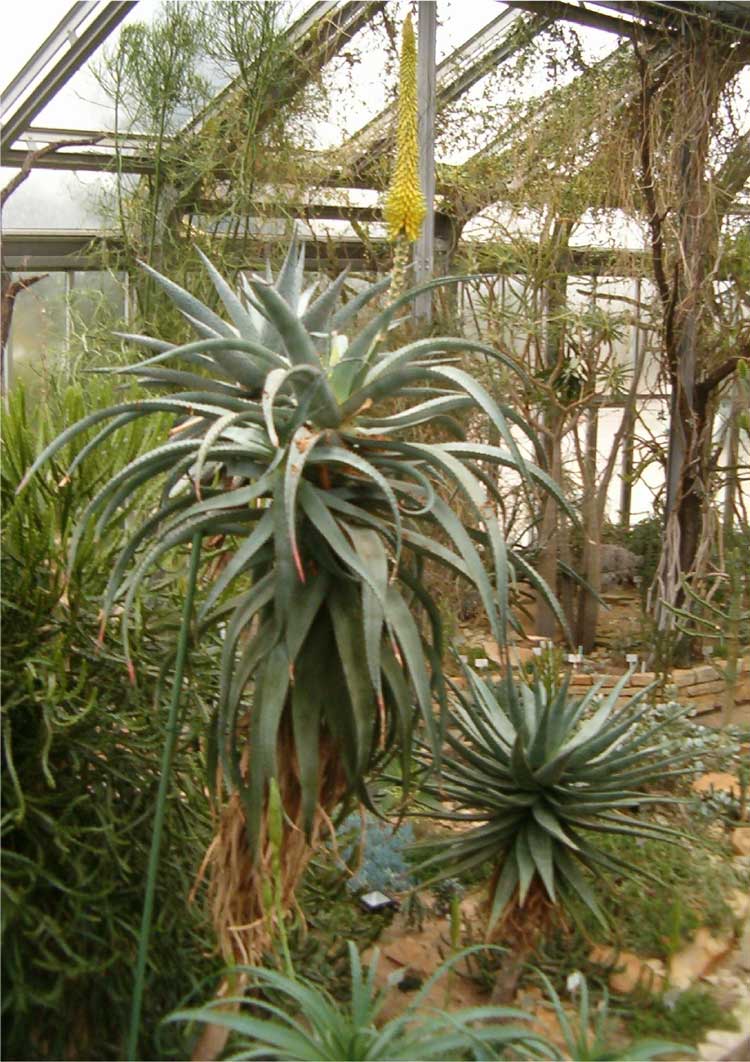
Aloe africana (*)
Classification System: APG IV
Superregnum: Eukaryota
Regnum: Plantae
Cladus: Angiosperms
Cladus: Monocots
Ordo: Asparagales
Familia: Asphodelaceae
Subfamilia: Asphodeloideae
Genus: Aloe
Species: Aloe africana
Name
Aloe africana Mill., 1768
Synonyms
Aloe africana var. angustio Haw.
Aloe africana var. latifolia Haw.
Aloe angustifolia Haw.
Aloe bolusii Baker
Aloe perfoliata var. africana (Mill.) Aiton
Aloe pseudoafricana Salm-Dyck
Pachidendron africanum (Mill.) Haw.
Pachidendron angustifolium (Haw.) Haw.
Distribution
Native distribution areas:
Continental: Africa
Regional:Southern Africa
Cape Provinces
References: Brummitt, R.K. 2001. TDWG – World Geographical Scheme for Recording Plant Distributions, 2nd Edition
References
Miller, P. 1768. Gard. Dict. ed. 8: Aloe no. 4.
USDA, ARS, National Genetic Resources Program. Germplasm Resources Information Network - (GRIN) [Online Database]. [1]
Links
Govaerts, R. et al. 2019. Aloe africana in World Checklist of Selected Plant Families. The Board of Trustees of the Royal Botanic Gardens, Kew. Published online. Accessed: 2019 Feb. 09. Reference page.
International Plant Names Index. 2019. Aloe africana. Published online. Accessed: Feb. 09 2019.
The Plant List 2013. Aloe africana in The Plant List Version 1.1. Published online. Accessed: 2019 Feb. 09.
Tropicos.org 2019. Aloe africana. Missouri Botanical Garden. Published online. Accessed: 09 Feb. 2019.
Vernacular names
Aloe africana (known as the Uitenhage Aloe) is an arborescent (tree-like) species of aloe plant, indigenous to the Eastern Cape Province, South Africa.
Description
Details of the tall, cylindrical raceme, showing the distinctively up-turned flowers
Typically disorderly rosette of slender spreading and recurved leaves
The plant grows slowly and flowers when it is four to five years old. Flowering time is from winter to early spring (July to September in South Africa). Its large raceme is erect and may be unbranched or have up to four branches, and has tubular flowers that are orange or yellow.
Uniquely, the small flowers are each up-turned, with a distinctive bend. As this aloe species can sometimes look very similar to related species (e.g. Aloe excelsa, Aloe lineata or Aloe ferox), this feature is useful for identification.
The thin, narrow leaves are more messy or disorderly than the neat symmetrical rosettes of other arborescent Aloe species. The leaves are also more recurved. They are arranged in a dense apical rosette and are spreading to recurved, firm linear-lanceolate, with a grey-green surface; each leaf's margins and lower side are armed with lines of small, reddish teeth, a feature common in the genus Aloe.[1]
The distinguishing features of this species therefore include: yellow-orange flowers that are bent to almost 90 degrees; racemes that are large, tall and tapering to a point; narrow spreading or recurved leaves, arranged in a relatively untidy rosette.[2]
Distribution and habitat
This attractive species occurs in the Eastern Cape of South Africa, where its distribution is centred on the area around Port Elizabeth and Uitenhage.
It is mainly confined to hills and flats, growing in thicket and renosterveld vegetation. However it is able to adapt to a wide range of conditions. It often grows in association with Aloe ferox, A. pluridens and A. speciosa, and hybrids are not uncommon. The climate is moderate, without frost, and hot and humid during summers. Rainfall occurs throughout the year, from 600 to 700 mm per annum.[3]
See also
Aloe
Asphodeloideae
Succulent plants
References
"Introduction to Tree Aloes, part 1: the solitary, unbranched species - Dave's Garden". davesgarden.com. Retrieved 2017-08-01.
"Introduction to Tree Aloes, part 1: the solitary, unbranched species - Dave's Garden". davesgarden.com. Retrieved 2017-08-01.
"PlantZAfrica.com: Plants of southern Africa". Archived from the original on 2009-03-01. Retrieved 2010-03-01.
Retrieved from "http://en.wikipedia.org/"
All text is available under the terms of the GNU Free Documentation License

